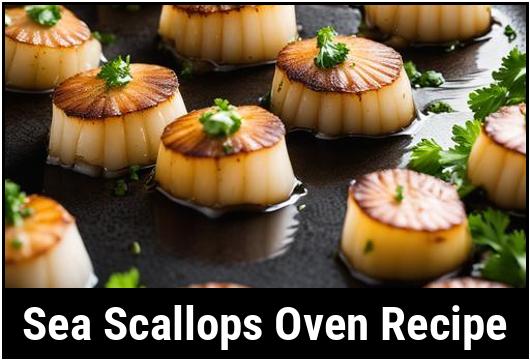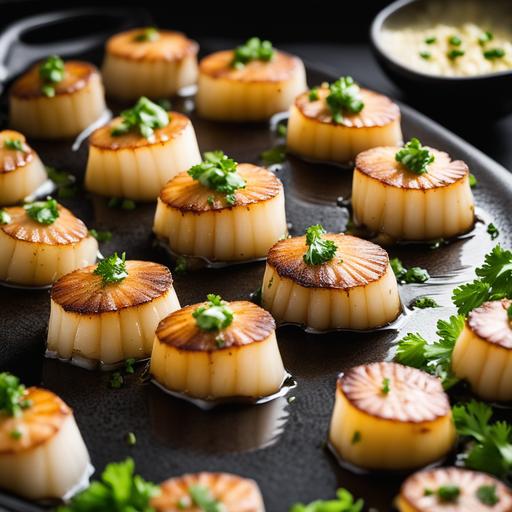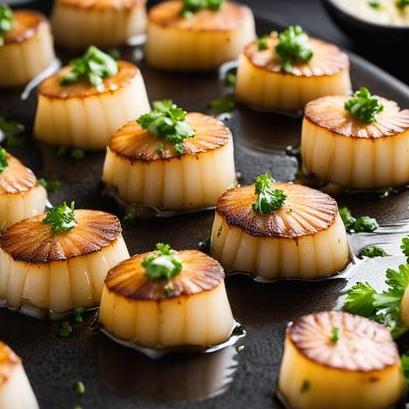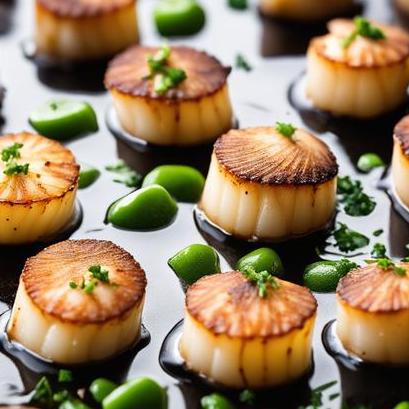
Sea Scallops Oven Recipe: A Comprehensive Guide
Sea scallops are a delicacy revered for their sweet, tender flesh and versatile nature in the kitchen. While commonly pan-seared, cooking sea scallops in the oven presents an equally delightful option, offering a hands-off approach that ensures consistent results. In this guide, we will delve into the art and science of oven-cooking sea scallops, exploring the optimal techniques and ingredients to create a mouthwatering dish that delights the palate.
Food Science Of Cooking Sea Scallops In An Oven
Understanding the science behind cooking sea scallops in the oven is crucial to achieving optimal results. Sea scallops are high in protein and low in fat, making them prone to overcooking, which can result in a tough, rubbery texture. Unlike their smaller counterparts, bay scallops, sea scallops require careful attention to ensure they are cooked to perfection.
When exposed to high heat, the proteins in scallops undergo denaturation, causing them to unfold and bond with one another. This process leads to the formation of a gel-like network, which traps moisture within the scallop, resulting in a tender, succulent texture. However, if subjected to excessive heat or prolonged cooking times, the proteins can become overcooked, leading to a loss of moisture and a tough, chewy consistency.
Cooking sea scallops in the oven allows for gentle, even heat distribution, minimizing the risk of overcooking. By preheating the oven to the optimal temperature and carefully monitoring the cooking time, you can ensure that the scallops reach the desired level of doneness without becoming tough or dry.
Choosing Ingredients
Selecting high-quality ingredients is essential for creating a delicious sea scallop dish. When choosing sea scallops, opt for fresh, dry-packed scallops, as they have a sweeter flavor and firmer texture compared to wet-packed scallops, which are treated with sodium tripolyphosphate to retain moisture.
Additionally, consider pairing the sea scallops with complementary ingredients to enhance their flavor profile. Ingredients such as butter, garlic, lemon, and fresh herbs like parsley or thyme can elevate the dish and add depth of flavor.
Preparing Ingredients

Properly preparing the sea scallops before cooking is crucial for ensuring even cooking and maximum flavor. Begin by patting the scallops dry with paper towels to remove any excess moisture, which can interfere with the Maillard reaction—the chemical process responsible for browning and flavor development during cooking.
Next, season the scallops with salt and pepper to taste, being mindful not to over-season, as the natural sweetness of the scallops should remain the star of the dish. For added flavor, you can also marinate the scallops in a mixture of olive oil, garlic, and lemon juice for a brief period before cooking.
Optimal Oven Cooking Temperature & Timing
Achieving the perfect balance of temperature and timing is crucial for oven-cooking sea scallops to perfection. Preheat your oven to 400°F (200°C) to ensure a consistent cooking environment that promotes even browning and caramelization.
When cooking sea scallops in the oven, timing is key. Aim to cook the scallops for 8-10 minutes, depending on their size, flipping them halfway through the cooking process to ensure even browning on both sides. The scallops should be opaque and slightly firm to the touch when done, with a golden-brown crust on the surface.
Sea Scallops Oven Recipe
Ingredients
- 1 lb (450g) fresh sea scallops
- 2 tablespoons olive oil
- 2 cloves garlic, minced
- Salt and pepper to taste
- Fresh parsley, chopped (for garnish)
- Lemon wedges (for serving)
Instructions
-
Preheat the oven: Preheat your oven to 400°F (200°C) and line a baking sheet with parchment paper or aluminum foil for easy cleanup.
-
Prepare the scallops: Pat the sea scallops dry with paper towels to remove excess moisture. Season with salt and pepper to taste.
-
Prepare the seasoning: In a small bowl, combine the olive oil and minced garlic to create a flavorful seasoning for the scallops.
-
Coat the scallops: Brush each sea scallop with the garlic-infused olive oil mixture, ensuring that they are evenly coated on all sides.
-
Arrange on baking sheet: Place the seasoned scallops on the prepared baking sheet, making sure to leave space between each scallop to promote even cooking.
-
Bake in the oven: Transfer the baking sheet to the preheated oven and bake the scallops for 8-10 minutes, flipping them halfway through the cooking process, until they are opaque and slightly firm to the touch.
-
Serve: Once cooked, remove the scallops from the oven and garnish with freshly chopped parsley. Serve hot with lemon wedges on the side for squeezing over the scallops before enjoying.
Cooking sea scallops in the oven offers a convenient and foolproof method for achieving perfectly cooked scallops with minimal effort. By understanding the science behind the cooking process and following a few simple steps, you can create a delicious dish that highlights the natural sweetness and tender texture of sea scallops. Whether served as an appetizer, main course, or part of a seafood feast, oven-cooked sea scallops are sure to impress even the most discerning palate.
Doneness Checks

Sea scallops, also known as large scallops or king scallops, are bivalve mollusks found in oceans around the globe. These delectable shellfish are prized for their sweet, briny flavor and buttery texture, making them a popular choice for seafood lovers. Cooking sea scallops in the oven is a straightforward method that requires minimal preparation and yields consistently delicious results.
Before diving into the recipe, it’s essential to procure high-quality sea scallops. Look for fresh or frozen scallops that are dry-packed, meaning they contain no added water or preservatives. Dry-packed scallops will caramelize beautifully when cooked, enhancing their natural sweetness. Avoid purchasing scallops treated with sodium tripolyphosphate (STP), as they tend to release excess moisture during cooking, resulting in a less flavorful dish.
Once you’ve obtained the finest sea scallops, it’s time to gather the necessary ingredients and preheat your oven. This recipe offers a simple yet elegant way to showcase the delicate flavor of scallops, making it perfect for both casual dinners and special occasions.
Achieving the ideal doneness when cooking sea scallops is crucial to ensuring a satisfying culinary experience. Overcooking can lead to tough, rubbery scallops, while undercooking may result in a raw or unpleasantly mushy texture. To ensure perfectly cooked scallops, consider the following doneness checks:
Visual Inspection
One of the most reliable methods for determining scallop doneness is visual inspection. Cooked scallops should appear opaque and slightly firm to the touch. The flesh should have a translucent quality, with no visible signs of rawness. Avoid overcooking the scallops, as they can quickly become dry and tough.
Temperature Probe
For precise doneness, use a kitchen thermometer to measure the internal temperature of the scallops. The USDA recommends cooking seafood, including scallops, to an internal temperature of 145°F (63°C). Insert the thermometer into the thickest part of the scallop to ensure accurate results. Be cautious not to overcook the scallops while waiting for the desired temperature to be reached.
Texture Test
Another method for assessing scallop doneness is the texture test. Cooked scallops should yield gently to pressure but still retain some springiness. If they feel mushy or overly soft, they may be undercooked. Conversely, if they feel firm or rubbery, they may be overcooked.
Undercooking
Undercooking sea scallops can result in a raw or unpleasantly mushy texture, diminishing their flavor and appeal. To avoid undercooking, ensure that the scallops are properly thawed before cooking, as frozen scallops may require additional time in the oven. Additionally, be mindful of cooking times and temperatures to achieve the desired level of doneness.
If you suspect that your scallops are undercooked, return them to the oven and continue cooking until they reach the appropriate temperature. Keep a close eye on them to prevent overcooking, as they can quickly go from undercooked to overcooked.
Overcooking
Overcooking sea scallops is a common mistake that can result in tough, rubbery flesh and a loss of flavor. To prevent overcooking, avoid leaving the scallops in the oven for longer than necessary and monitor their doneness closely. It’s better to slightly undercook the scallops than to overcook them, as they will continue to cook slightly after being removed from the oven.
If you find that your scallops are overcooked, there are a few steps you can take to salvage them. Consider slicing the scallops thinly and incorporating them into pasta dishes or salads, where their texture may be less noticeable. Alternatively, chop the scallops finely and use them as a filling for seafood cakes or stuffing for vegetables.
Troubleshooting

Even with careful preparation, unexpected issues may arise when cooking sea scallops in the oven. Here are some common troubleshooting tips to address potential problems:
Excess Moisture
If your scallops release excess moisture during cooking, resulting in a soggy texture, try patting them dry with paper towels before placing them in the oven. Removing excess moisture will promote better caramelization and prevent the scallops from becoming watery.
Uneven Cooking
To ensure even cooking, arrange the scallops in a single layer on a baking sheet, leaving space between each scallop. This allows hot air to circulate evenly around each scallop, promoting consistent cooking. If using multiple baking sheets, rotate them halfway through the cooking process to ensure uniform heat distribution.
Lack Of Flavor
If your scallops lack flavor, consider marinating them before cooking to infuse them with additional taste. A simple marinade of olive oil, garlic, lemon juice, and herbs can enhance the natural sweetness of the scallops and add depth to their flavor. Alternatively, serve the cooked scallops with a flavorful sauce or garnish, such as a tangy citrus aioli or a zesty salsa verde.
Recipe Variations
While the basic oven-roasted sea scallop recipe is delicious on its own, there are countless variations to explore, each offering a unique twist on this classic dish. Here are a few recipe variations to inspire your culinary creativity:
Bacon-Wrapped Scallops
For a decadent twist on traditional oven-roasted scallops, wrap each scallop in a strip of bacon before baking. The bacon adds a savory richness that complements the sweet flavor of the scallops, creating a mouthwatering combination of textures and tastes.
Scallop Gratins
For an elegant appetizer or main course, prepare scallop gratins by topping each scallop with a mixture of breadcrumbs, Parmesan cheese, and herbs before baking. The breadcrumbs form a golden crust that adds crunch and flavor to the tender scallops, making them irresistible to the palate.
Citrus-Glazed Scallops
For a burst of vibrant flavor, glaze the scallops with a citrus-infused sauce before baking. Combine orange juice, honey, soy sauce, and ginger in a small saucepan, then simmer until thickened. Brush the glaze over the scallops before baking, allowing the flavors to meld together and create a tantalizing contrast of sweet and tangy notes.
Cooking sea scallops in the oven is a simple yet elegant way to showcase the natural sweetness and tender texture of these beloved shellfish. By following the tips and techniques outlined in this article, you can achieve perfectly cooked scallops with minimal effort and maximum flavor. Whether you prefer classic oven-roasted scallops or want to experiment with creative recipe variations, there are endless possibilities to explore. From bacon-wrapped scallops to citrus-glazed delights, each variation offers a unique culinary experience that is sure to delight your taste buds. So, fire up your oven, gather your ingredients, and embark on a culinary adventure with sea scallops. Whether you're hosting a dinner party or enjoying a quiet evening at home, these oven-roasted delicacies are sure to impress even the most discerning seafood aficionados.
Flavour Enhancement Tips
Sea scallops, prized for their delicate flavor and tender texture, are a seafood delicacy enjoyed by many. Cooking sea scallops in the oven is a fantastic way to preserve their natural sweetness and succulence while adding layers of flavor and texture.
1. Marinades
Marinating sea scallops before baking can infuse them with extra flavor. Opt for marinades with complementary ingredients such as citrus juices, garlic, herbs like thyme or parsley, and a touch of olive oil. Allow the scallops to marinate for at least 30 minutes in the refrigerator before cooking to let the flavors meld.
2. Seasonings
Simple yet effective, seasoning your sea scallops generously with salt and pepper before baking can enhance their natural taste. Consider adding other seasonings like paprika, cayenne pepper, or lemon zest for an extra kick.
3. Butter And Wine
Create a decadent sauce by baking sea scallops in a mixture of melted butter and white wine. The butter adds richness, while the wine lends acidity and depth of flavor. You can also incorporate minced shallots or garlic for added complexity.
Texture Enhancement Tips

1. Searing
For a crispy exterior and a tender interior, sear the sea scallops in a hot skillet before transferring them to the oven. Searing caramelizes the surface of the scallops, creating a beautiful golden crust that contrasts with the soft flesh inside.
2. Bread Crumbs
Coating sea scallops with breadcrumbs before baking adds a delightful crunch to each bite. You can use seasoned breadcrumbs for extra flavor or mix in grated Parmesan cheese for a cheesy crust.
3. Bacon Wrapping
For an indulgent twist, wrap each sea scallop with a slice of bacon before baking. The bacon adds smokiness and richness to the dish while keeping the scallops moist and succulent.
Cooking At Different Temperatures
1. High Temperature
Baking sea scallops at a high temperature, around 400°F (200°C), is ideal for achieving a golden crust while keeping the interior tender. This method is perfect for quick cooking and works well with seared scallops or those coated in breadcrumbs.
2. Low Temperature
Cooking sea scallops at a lower temperature, around 325°F (160°C), results in a slower, more gentle cooking process. This allows the scallops to cook evenly without becoming tough or rubbery. Low-temperature baking is ideal for scallops baked in a sauce or wrapped in bacon.
3. Broiling
Broiling sea scallops is a quick and efficient method that gives them a beautiful caramelized exterior. Preheat the broiler and place the scallops on a baking sheet or in a broiler pan. Broil for 3-4 minutes per side, or until the scallops are golden brown and cooked through.
Cooking Tips
1. Pat Dry
Before seasoning or marinating the sea scallops, pat them dry with paper towels to remove excess moisture. Dry scallops will brown better and develop a nice crust when baked.
2. Evenly Sized
For uniform cooking, choose sea scallops that are similar in size. This ensures that they cook at the same rate and prevents smaller scallops from overcooking while larger ones are still raw in the center.
3. Properly Preheated Oven
Ensure your oven is preheated to the correct temperature before baking the scallops. A hot oven ensures that the scallops cook quickly and evenly, resulting in perfect texture and flavor.
4. Use A Baking Dish
Arrange the sea scallops in a single layer in a baking dish or on a baking sheet lined with parchment paper. Crowding the scallops can cause them to steam rather than brown, so leave some space between each one.
Serving Suggestions
1. Lemon Wedges
Serve the baked sea scallops with lemon wedges on the side. The bright acidity of the lemon cuts through the richness of the scallops, balancing the flavors beautifully.
2. Fresh Herbs
Garnish the dish with fresh herbs like parsley, chives, or dill for a pop of color and freshness. The herbs add a fragrant aroma and a burst of flavor to each bite.
3. Side Dishes
Pair the baked sea scallops with your favorite side dishes such as roasted vegetables, garlic mashed potatoes, or a simple green salad. The versatility of scallops makes them a perfect accompaniment to a wide range of flavors and textures.
Conclusion
Cooking sea scallops in the oven is a delicious and versatile way to enjoy this delectable seafood. By following these flavor and texture enhancement tips, mastering the cooking process, and serving the scallops with complementary accompaniments, you can create a memorable dish that will impress even the most discerning palates. Whether you’re cooking for a special occasion or simply indulging in a gourmet meal at home, this sea scallops oven recipe is sure to delight.
FAQS
Where Can I Buy Fresh Sea Scallops For This Recipe?
You can purchase fresh sea scallops at your local fish market, grocery store, or online seafood vendors. Look for scallops that have a sweet, briny smell and are shiny and firm to the touch.
How Should I Thaw Frozen Sea Scallops Before Cooking Them In The Oven?
The best way to thaw frozen sea scallops is to place them in the refrigerator overnight. If you need to thaw them quickly, you can also seal them in a plastic bag and submerge them in a bowl of cold water for about 30 minutes.
What Temperature Should The Oven Be Set To When Cooking Sea Scallops?
Preheat your oven to 425 degrees Fahrenheit (220 degrees Celsius) for this recipe. This high temperature ensures a quick sear and helps to retain the natural juices and tenderness of the scallops.
How Long Should I Cook Sea Scallops In The Oven?
The cooking time can vary depending on the size of the scallops. In general, for medium-sized sea scallops, bake them in the preheated oven for about 8-10 minutes, or until they are opaque and have a slightly golden crust on top.
Can I Prepare The Sea Scallops In Advance And Refrigerate Them Before Baking?
Yes, you can prepare the scallops in advance and refrigerate them for a few hours before baking. Arrange them on a baking sheet, cover tightly with plastic wrap, and place in the refrigerator until ready to cook. Remember to remove them from the refrigerator and let them come to room temperature for about 10-15 minutes before baking.


